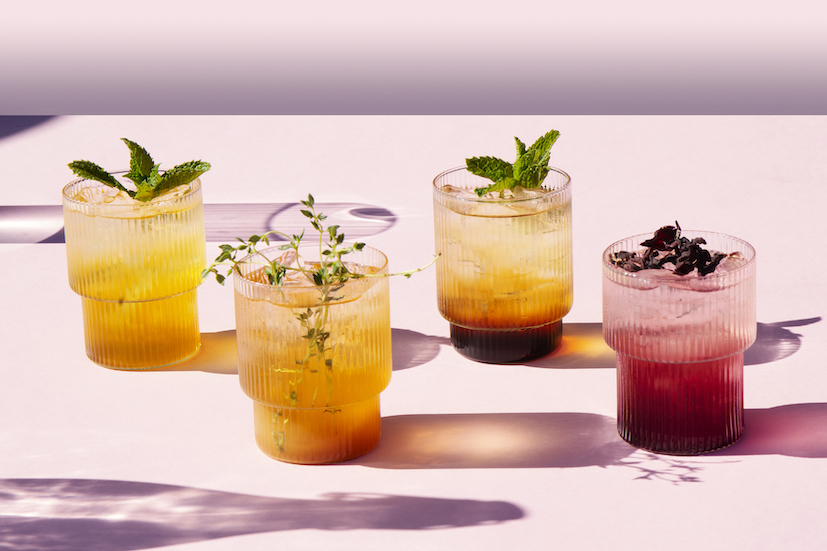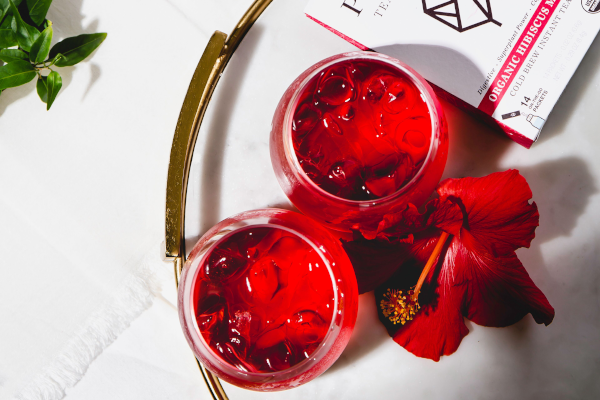One of the great things about the world of tea is its variety. Different plant varieties, growing climates and brewing methods create endless possibilities when it comes to flavor and antioxidant profiles. And that includes herbal tea.
What is Herbal Tea?
Did you know that herbal tea isn’t actually tea at all? Not in botanical terms, anyway.
True “tea” can be made only from the leaves of the tea plant, also known as Camellia sinensis. The varieties of true tea include black tea, Pu’er teas, oolong, white, yellow, and green teas.
Herbal teas (also known as “tisanes”) are made by infusing herbs, flowers, spices, roots, and really any other plant product in hot water. Same concept, but very different histories and health benefits.
Best Herbal Teas
- Chamomile
- Ginger
- Lavender
- Hibiscus
- Peppermint
- Rooibos
History of Herbal Medicine
Herbs feature prominently in ancient medicinal traditions.
In Traditional Chinese Medicine, tea was believed to reduce inflammation, a contributing factor to many types of disease.
Tea, both true and herbal, was thought to reduce fever, soothe gastrointestinal discomfort, support weight loss, lift lethargy and generally help to detox the body. Recipes and recommendations for herbal remedies can be found in Chinese medical texts dating as far back as the late 600s AD. [1]
Today, many studies have supported regular tea consumption as one method that may help support overall health and longevity, in conjunction with other healthy habits like a nutritious diet and exercise. [2]
Health Benefits of Herbal Teas
Because herbal teas can be made from a variety of plants, the chemical properties, and subsequent health effects will vary depending on the ingredients.
In general though, herbal teas tend to have antioxidant and anti-inflammatory properties, as most plant-based foods do. [3][4]
What most distinguishes herbal beverages from true tea is that they are caffeine-free.
So especially if you’re looking for something soothing to drink during the evening hours, herbal tea is an excellent alternative.
Best Types of Herbal Tea to Try
Because herbal teas can be made from just about any plant, the options are endless when it comes to flavor and aroma.
Here are some of the more popular varieties and why you should drink them:
1. Chamomile
Tea made from this daisy-like flower is one of the oldest and most-studied herbal infusions, known in particular for its sleep-inducing properties.
Studies suggest that the flavonoid apigenin may be responsible for this effect. Apigenin binds to the same receptors in the brain as the anxiety drug benzodiazepine, which ultimately has the effect of quieting the central nervous system.[5]
While not approaching the strength of a prescription, chamomile tea can nonetheless have a calming effect that primes the body for sleep. [6]
A cup of chamomile can also help you feel better when you’re under the weather. Chamomile has been shown to have properties that can help to relieve symptoms from when you’re feeling sniffly and unwell. [5]
The aroma and flavor of chamomile tend to contain both floral and earthy notes, but it quickly becomes bitter if over-brewed. Steeping dried chamomile leaves — loose or bagged — in just-below-boiling water for five minutes should do the trick.
While tasty on its own, a tablespoon of honey can amp up chamomile’s sweet notes.
2. Ginger
Tea made from ginger root is known for its spicy kick and legendary ability to soothe upset stomachs.
A review of more than 100 studies found that ginger was generally effective in alleviating nausea and indigestion. It also has an anti-inflammatory effect that may help to support a healthy immune system. [7][8]
The effects are more pronounced when using fresh ginger, which also produces a stronger flavor. Because ginger is a root and not a flower or leafy plant, the brewing process is a little different.
For one mug of ginger tea, you’ll want about two tablespoons — roughly an inch and a half — of fresh ginger. A spoon is a great tool for peeling ginger root because it can more easily (and safely) manipulate its bumps and grooves.
Slice your ginger root and drop it into boiling water, then reduce to a simmer. You’ll want to let the ginger infuse for at least 10 minutes, but the longer it cooks, the stronger the flavor will be.
3. Lavender
Most of us know lavender for its essential oils, used in beauty and cosmetic products or in aromatherapy. Applied topically, research suggests it can help to combat inflammation and promote healing. Its pleasant scent is said to help have a calming effect.[9][10] But what benefits do lavender’s leaves provide in tea?
Some studies suggest that lavender can ease gastrointestinal distress and bowel issues by supporting a healthy and diverse microflora in the gut. [11] While lavender tea isn’t recommended as a treatment for any stomach-related issues, regular consumption may support overall digestive and immune health.
A cup of lavender can also serve as a small dose of aromatherapy. Lavender is best consumed just before bed to make the most of its calming, sleep-inducing qualities.
To make a cup of lavender tea, use fresh buds instead of dried — about four teaspoons per cup. Pour boiling water over the buds and let steep for about 10 minutes before straining. Lavender tea has a very floral aroma and taste, which some might consider “soapy.” Adding a squeeze of lemon juice can help to balance the flavor and make the tea more palatable.
4. Hibiscus
Hibiscus tea has become popular not only for its purported health benefits but for its beautiful deep crimson color and tart flavor.
Hibiscus flowers are high in antioxidants and contain flavonoids shown to support healthy blood pressure levels. [12][13][14].
It’s also a good source of vitamin C. Phytochemicals called anthocyanins, the same compounds that give blackberries, blueberries, and raspberries their color, are thought to be responsible for hibiscus tea’s heart-healthy properties.
To make a cup, use a quarter-cup of fresh hibiscus flowers, or a tablespoon of dried leaves. Fresh hibiscus can be difficult to come by, but many bagged varieties are available. Fresh leaves will need a little longer to steep to fully extract their flavor — up to 20 minutes. Dried hibiscus will usually take fewer than 10 minutes to steep.
This flower imparts a tart flavor with some sweet undertones that many find pleasant on its own, but that is also complemented well by a tablespoon of honey. It also makes a divinely refreshing iced tea.
5. Peppermint
Peppermint tea is another herbal infusion that has been around for ages, spanning cultures. People from the ancient Greeks to modern-day Moroccans drink peppermint tea as a digestif, to cleanse the palate, soothe the tummy, and even increase satiety.
Mint is a plant jammed with antioxidants, giving this tea plenty of immune-supporting properties. Peppermint contains menthol, menthone, rosmarinic acid, caffeic acid, flavones, flavanones, terpenes, and vitamin C (26)(27).
You can find mint tea in tea bags, as loose-leaf dried herb, or – the best way – high-quality fresh herb, preferably home-grown. Here’s how to make your own spearmint or peppermint tea:
Boil 2 cups of water. Remove the boiling water from heat. Crush or tear a generous handful of mint leaves, then add them to the hot water. Cover, then steep 5 minutes. Strain the tea, then drink and enjoy!
6. Rooibos
Rooibos tea is truly unique, made from a bush native to (and only found in) South Africa. Also known as “red bush” tea, rooibos has an earthy, robust flavor reminiscent of vanilla.
Rooibos is free of tannins and so mild and gentle on the stomach, people in South Africa have been giving it to colicky babies for generations.
Perhaps rooibos’ biggest claim to fame is its very unique antioxidant content. Specifically, it contains at least two health-enhancing compounds (aspalathin and alpha hydroxy acid) that do not exist in any other natural source that you can ingest. It’s also the only tea that provides quercetin, a powerful weapon against fighting free radicals in the body.
DIY Herbal Tea Blends
You may have noticed that most herbal tea recipes call for fresh ingredients where possible. Of course, it’s not always cost-effective or convenient getting your hands on fresh flowers or spices to satisfy a tea craving. The good news is that delicious infusions can be made from just about any herb you can grow in your backyard or on your windowsill.
You can also buy fresh herbs in bulk and dry them yourself to create your own mixes. Some great options include mint, basil, rosemary, sage, thyme, dandelion, lemongrass, and fennel — herbs you’ll likely use in many other recipes and that can be dried and stored easily for later use. (You can even use spices like turmeric!)
There are a few ways to dry herbs. The fastest method is oven-drying. Lay your herbs out on a cookie sheet. Set the oven to a low temperature – around 150 degrees, and let the herbs “cook” for anywhere from two to four hours. Check on them periodically; when the leaves crumble easily, they’re ready.
You can also air-dry your herbs, which preserves more of their antioxidants and flavor but takes longer. For this method, tie your herbs into small bundles and place them in a paper bag, stem-side out. Tie the bag closed and poke some holes in it to allow for ventilation. Hang the bag in a warm room and let them do their thing. It can take up to one week for herbs to thoroughly dry this way.
It’s best to store your newly-dried herbs whole in an airtight container or plastic bag. Wait to crumble them up until you use them, or you risk destroying some of the flavor compounds. Dried herbs can last for up to a year before they lose their potency. As a rule of thumb, one teaspoon of dried herbs generally equates one tablespoon of fresh for each cup of tea.
The Final Word
Herbal teas deliver all the health benefits of antioxidants without the caffeine, and because you can brew just about any type of herb, spice, or flower, the flavor options are endless. This list offers an introduction to some popular varieties, but don’t be shy about branching out and adding some herbal infusions to your tea collection!








